Neither snow nor rain nor heat nor gloom of night can stop our weekly ACC updates. I hope that everyone stuck in what passes for a blizzard in the southeast is most of all warm and safe…followed closely by continuing cable/satellite and internet access.
Just remember that you can’t fix stupid because I’m sure that there will be a lot of that driving around. Driving in snow (even for someone from NC) is not that difficult, but driving in a pinball machine can be quite hazardous. Here in Central VA, it looks like our accumulation was towards the bottom of what was forecasted (~6-8 inches) with a chance for some more this afternoon. If my company decides to open tomorrow, I expect that I will develop an “eye problem”; as in “I just can’t see it”.
We have another thread for the weather anyway, so let’s move on to the update. I have adjusted the scale on our two charts so that they both display RPI rankings from 35-45 to give a little context to the way UNC and FSU have moved over the last several weeks. As long as you recognize that FSU’s inclusion is a sign of what used to be, then I expect that most people would agree that these five teams are near certain locks for the NCAAT. It would take a collapse of Herbian proportions (circa 2000) to move any of these teams to the NIT.
WARNING – Those who go cross-eyed when the details of RPI calculations are discussed should start skimming now.
As predicted, the movement of these teams through the Top 40 has essentially plateaued. I’ve never dug into the minutiae of the calculations, but there has to be several different effects going on. First, as the number of games played increases, the change in the calculated RPI results for any one game begins to decrease. If the calculated RPI value doesn’t change very much, then the ranking can’t change very much either.
Another effect is that all of the vertical blanks in our charts are actually other teams. As the season moves on, the riff-raff (like FSU) falls away and eventually is out of the picture. So at some point in the season, upward movement mostly happens as the teams above you lose. (Of course, downward movement is not impeded.)
I expect that most of our readers understand why an undefeated Syracuse (and Wichita St) are not at the top of the RPI rankings….Strength of Schedule. It’s not that Syracuse has a weak schedule, but there are a lot of teams with stronger ones (51 teams to be exact)…and the strongest schedules are simply insane. For example, check out Kansas (#1 in SOS and RPI):
- 9 out of 24 games are against Top-25 teams.
- 14 out of 24 games are against Top-50 teams.
- Only 3 games are against #100+ teams
Let’s move to the bubble teams for another example of the effect of SOS and winning percentage play out in the RPI Rankings.
From our chart, UNC bottomed out on Jan 23 with a 1-4 conference record. Yet FSU appears to be in free fall with a 5-7 conference record. Why the difference? UNC’s OOC SOS is ranked 24th and helped cushion their fall at the start of the ACC schedule. FSU’s overall schedule is ranked #41 and provides less cushion. There is also a matter of perspective as UNC quit losing by the end of Jan and no one knows when FSU will stop.
Let’s take a closer look at UNC’s five game winning streak. The streak is made up of home wins against the middle of the conference (UMD, Clemson, and NCSU) and on the road against teams from the bottom third of the conference (GT and ND). This lucky bit of scheduling maximized the chances of winning by having what should have been the toughest teams travel to CH and maximized the RPI effect by playing the weakest teams on the road. (They also dodged the two RPI anchors in the ACC, BC and VT, during the winning streak.)
What’s interesting is that the win at ND had essentially no effect on their RPI ranking? Why? Let’s start with the simplified RPI formula.
I checked on Wednesday and found that UNC had one of the highest RPI rankings for a team with seven losses. I don’t intend to calculate or even look up the adjusted winning percentages, but their overall SOS ranking is #21. So it follows that their winning percentage has caused their RPI ranking to plateau in the upper 30s. Exactly like Kansas’ #1 SOS has moved their RPI ranking (even with six losses) above Syracuse’s undefeated ranking. Bottom line…both SOS and winning percentage have big effects on a team’s RPI and you have to consider both when evaluating changes in RPI rankings.
If anyone wants to discuss/argue/question my RPI conclusions, we can hash out any issues in the comments. But let’s bring back the folks reading through glazed-over eyes. If you were skimming to find the end of the RPI crap, it’s safe to start reading again.
A WORD ABOUT FSU FROM MG
What are you doing? You’re killing me!
With two wins (against teams that will playing on Wed in the ACCT), State is at its highest point in the RPI rankings since conference play began. But FSU’s collapse leaves State with only one Top 50 win and Tenn is barely hanging on at #50 today. Bottom line, State fans need State, FSU, and Tenn to get more wins NOW. FSU’s collapse adds even more importance to the UNC game in Raleigh.
HOW TO GET OUT OF A HOLE
In the basketball world, there are a lot of people staring down at the bubble teams. The problem is that all those at the top of the hole are going to be even less help than Piglett. The bubble teams dug their own hole and it’s going to up to them to see which ones can climb out. Let’s highlight two ACC teams from the past that managed to climb out of deep holes.
A few words of clarification:
– The opponents RPI ranking is that team’s final ranking for the year.
– The only OOC games listed are Top 50 wins.
– The RPI rankings down the right hand side of the tables show how the RPI changed through the ACC schedule and ACCT.
Both teams finished the regular season with 7-9 conference records, which is a really big negative on Selection Sunday. So we can consider both of these examples as “worst-case”.
Let’s look at few similarities between these two teams.
– From Feb 1 through the end of the ACCT, both teams compiled a 6-6 record. Conclusion: a red-hot finish is not required to overcome a poor start.
– Both teams had multiple Top-50 wins and both teams had at least one Top 25 win. Conclusion: if you want to get an at-large bid, you need several victories worth noting.
– Both teams beat MOST of the teams that they were supposed to beat, but both teams stumbled in Feb. Conclusion: You can still recover from a bad game, even at the end of the regular season (check out UMD’s bad loss to UVA just before the ACCT).
– Both teams beat an RPI Top 25 in the ACCT. Conclusion: A big win in the ACCT is very good and most likely required.
Within the last several years, the Selection Committee has specifically stated that all wins will be given equal weight regardless of when they occurred in the season. Before this statement was made, it was easy to show that wins in conference tournaments were given more weight. I’m still waiting on a good example where a bubble team got in with Dec wins over a team with March wins. So until proven otherwise, I’m going to assume that a big win in the ACCT carries as much weight today as it has in the past.
It’s especially interesting to note that in 2005, NCSU’s RPI ranking was #76 before the ACCT; which is worse than any team that has ever received an at-large bid. Unless I’ve missed something over the last few years, this NCSU team’s final ranking of #63 is the worst RPI ranking of any BCS team that received an at-large bid to the NCAAT.
So it is possible to dig yourself out of a hole as long as you are actually good enough to beat good teams. It is not particularly clear that any of the four ACC teams within the historical bubble range are in fact good enough to earn an at-large bid. But as we saw with several of Herb’s NCSU teams, it doesn’t take that many big wins to earn an at-large bid.
Upcoming NCSU Schedule
State finishes up its terrible early Feb schedule with road trips to Syracuse on Sat and Clemson/VT next week. Going 0-2 between now and next week’s update would NOT aid in climbing out of the hole State finds itself in.
Next week’s update won’t be out until Friday so that we can capture the rankings after the Thursday night UNC/Duke makeup game.


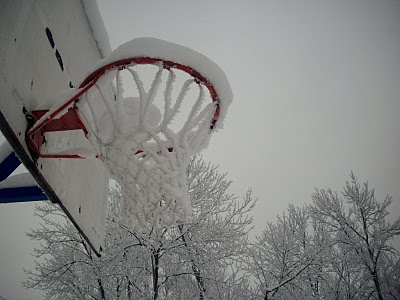
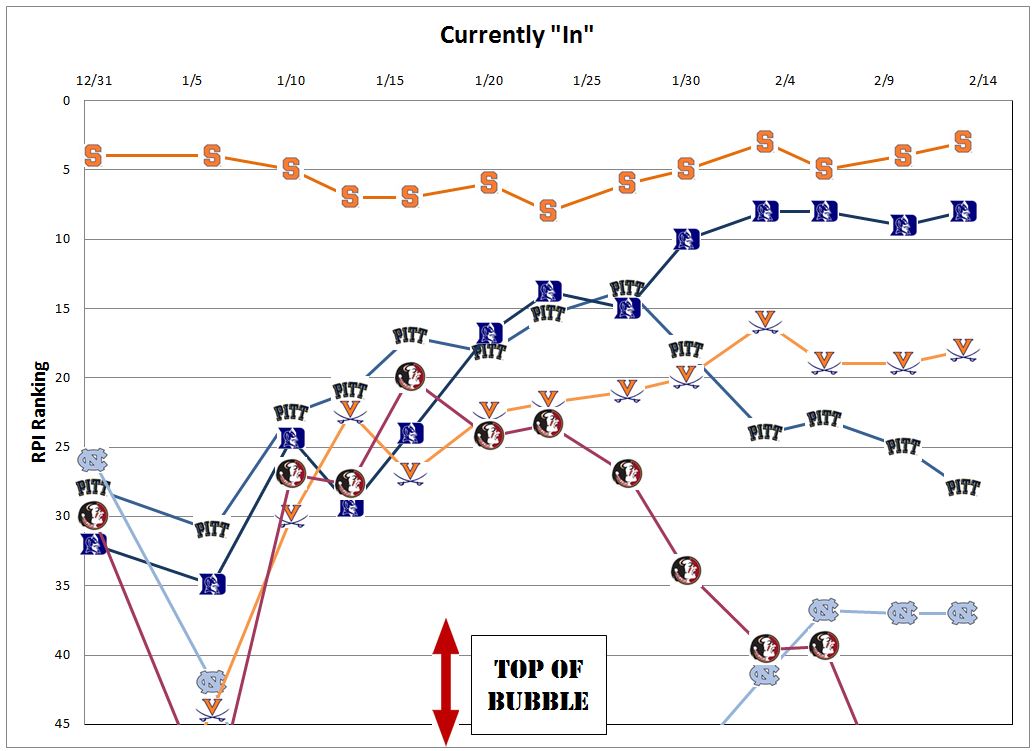
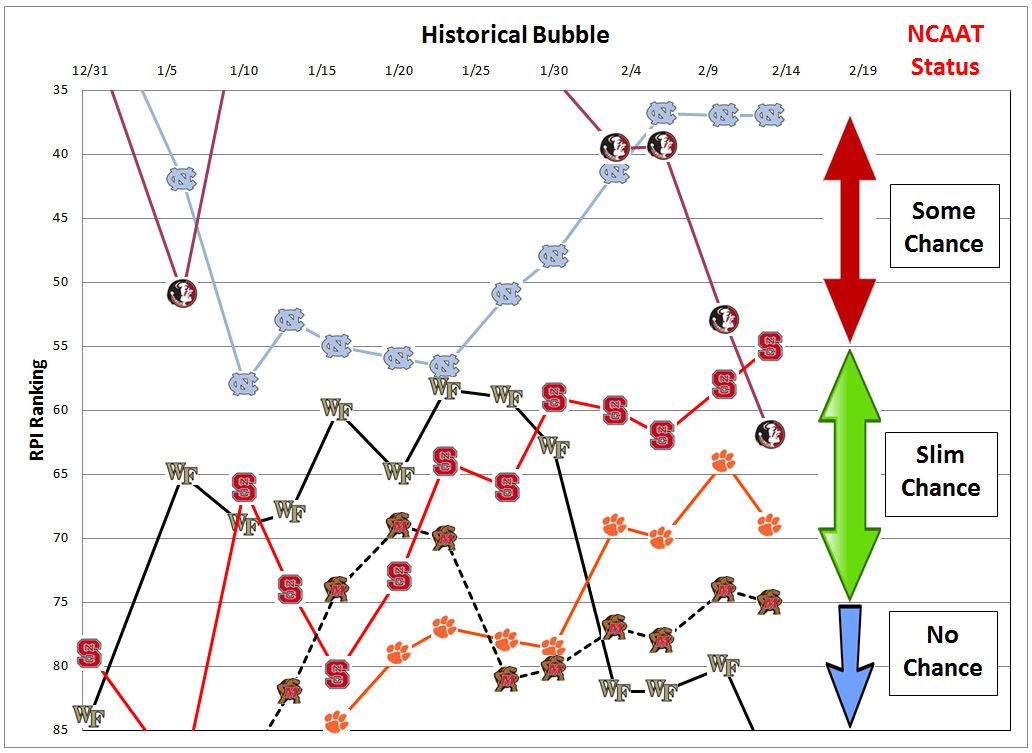
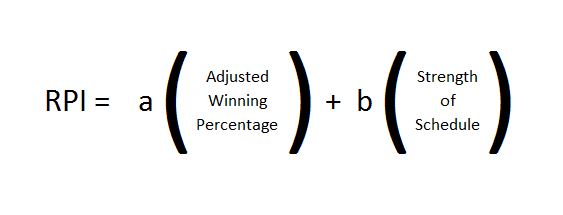
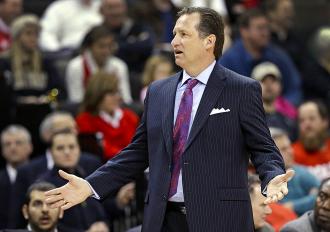

![NCSU-2005[1]](https://www.statefansnation.com/wp-content/uploads/2014/02/NCSU-20051.jpg)
![UMD-2009[1]](https://www.statefansnation.com/wp-content/uploads/2014/02/UMD-20091.jpg)

You must be logged in to post a comment.